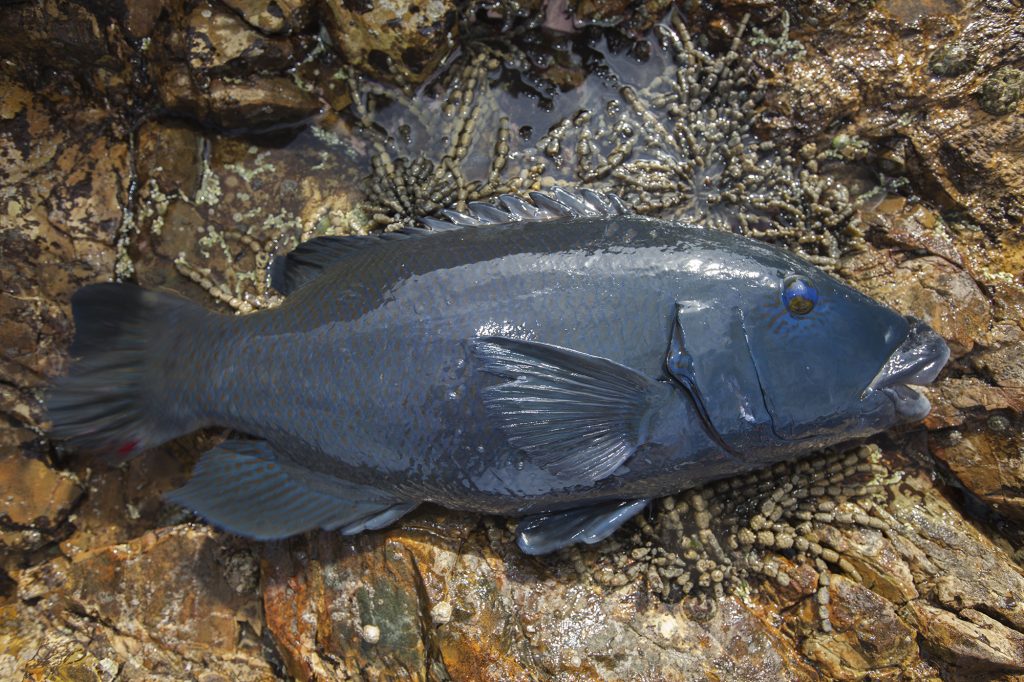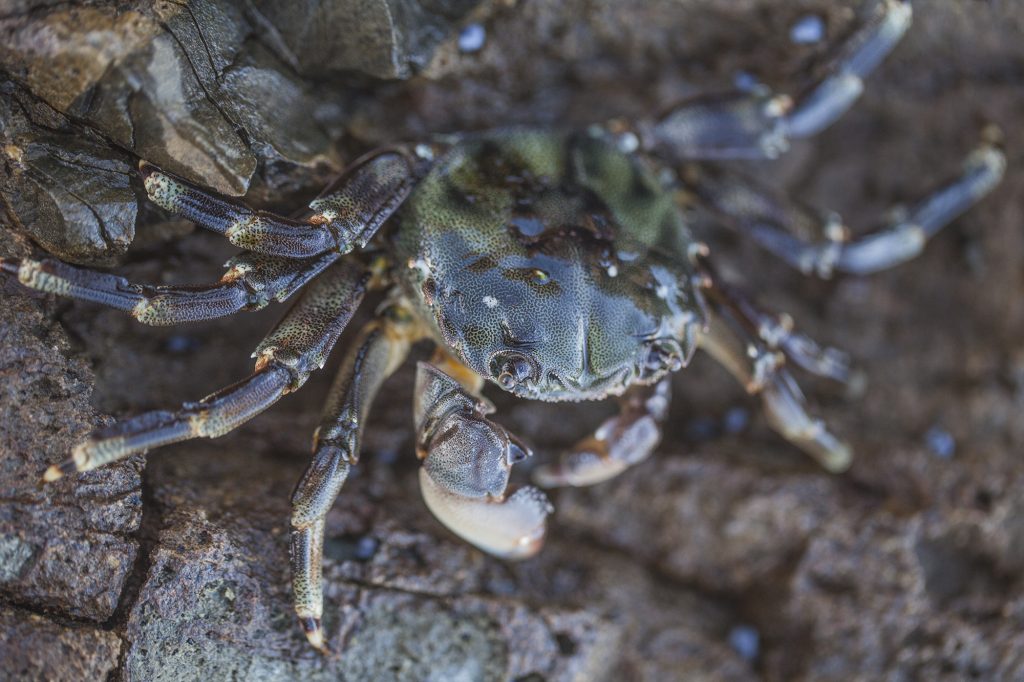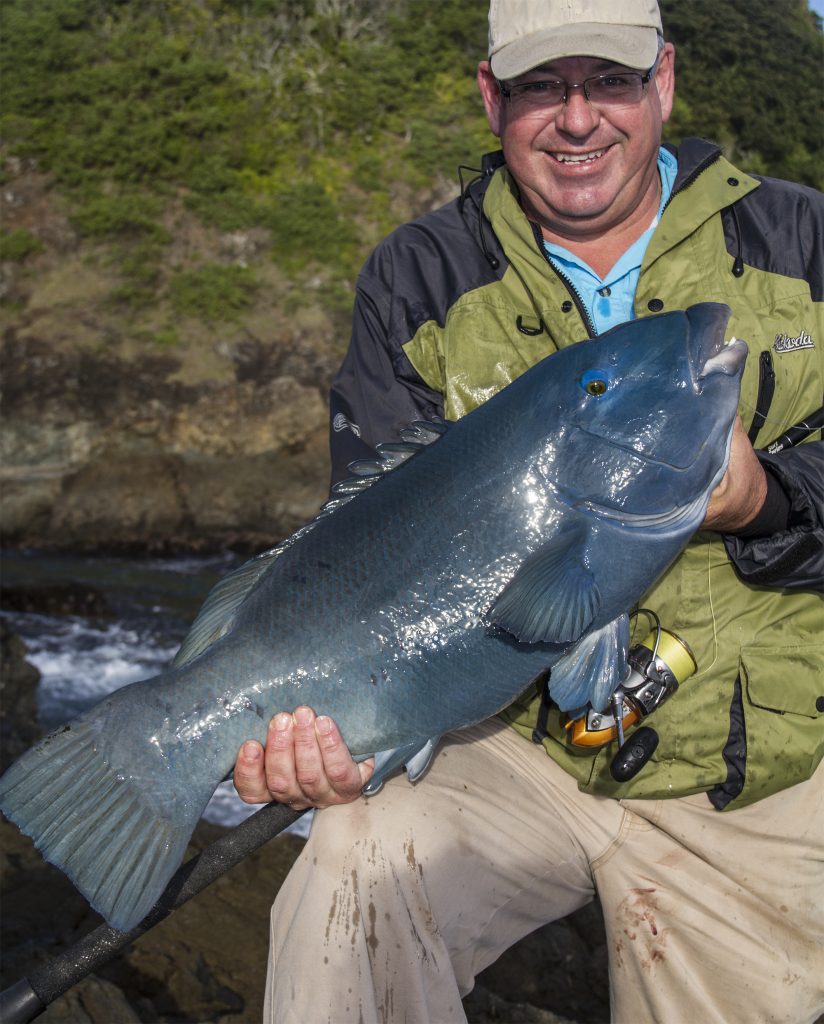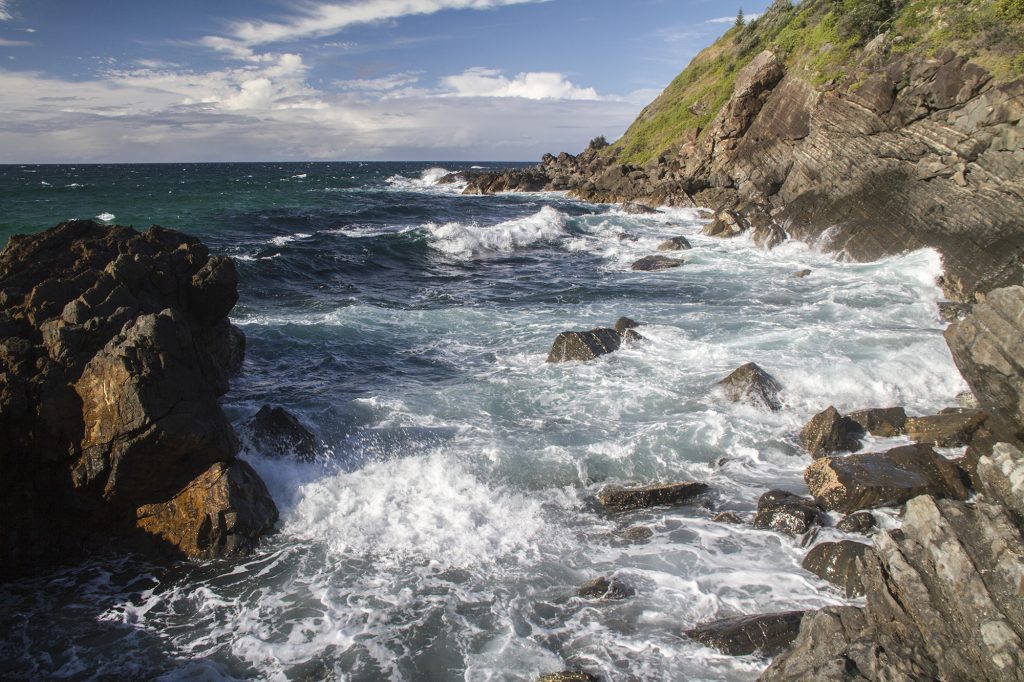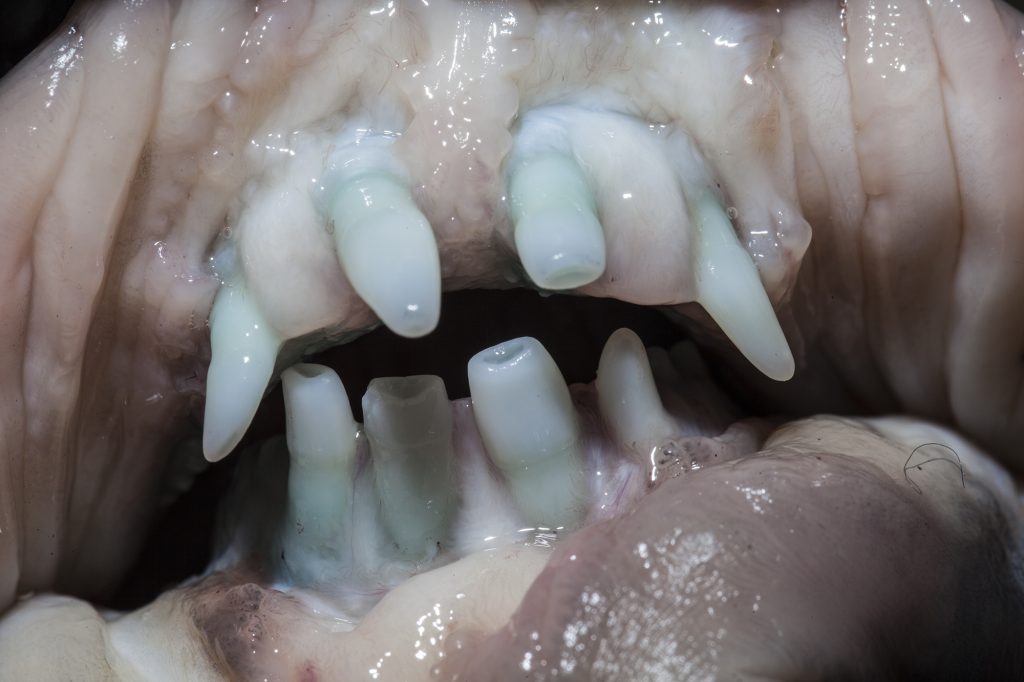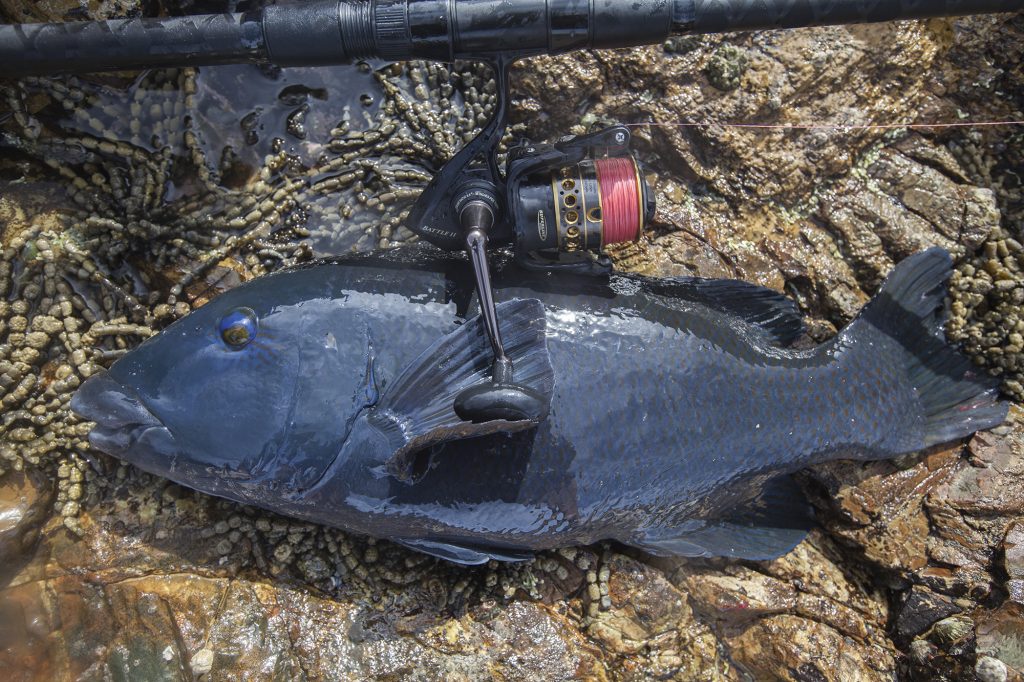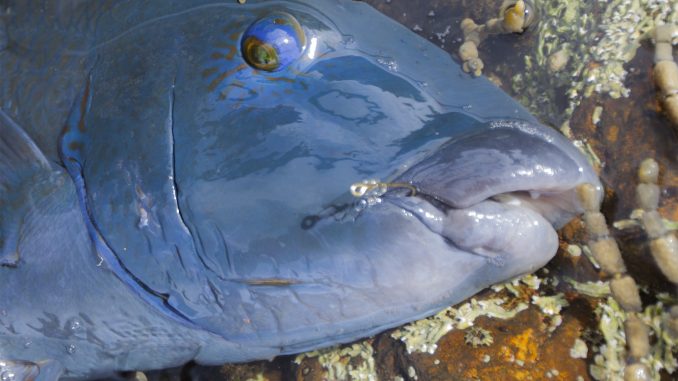
by David Seaman •
There are few more challenging fish from the ocean rocks, for the bread and butter angler, than the blue groper. Winter is the best time to target trophy groper from the rocks, but remember to be gentle and return the big blues to the water.
This tenacious brawler is, in fact, the largest member of the wrasse family of fishes with the western blue groper (Western Australian species) growing substantially larger than its cousin, the eastern blue groper, on the other side of the country. Attaining a maximum size of around 25kg and 1.2m in length, the eastern blue groper is a formidable fish whether encountered as by-catch while general bait fishing or indeed targeted by anglers. The groper’s distribution is widespread, touching South Australia, the east and north coasts of Tasmania, and the entire eastern seaboard of Victoria and NSW.
Meet the groper
Groper on the NSW coast are prolific and there’s been a change from the mid 1960s where it was exploited by anglers, spear fishers and commercial gill netting until the protection order in the ‘70s and the prohibition of their sale in 1980. Since the lifting of the fishing ban in 1974 to rod and line anglers, the species has once again adopted its place in amongst the broken rocky shorelines of the state and the close inshore island refuge of deeper water.
Unlike other fish, where the female is the largest of the species, the large, distinctive blue specimens of groper are male and command a territory or area of coast filled with smaller females. What is interesting is that should the local male fish die or be taken from the water, the most dominant female changes sex and adopts the role as the propagating male. This ability to change sex is called protogynous hermaphroditism, and with the role and responsibility of the male comes the blue metal to bright blue colouration.
The sex change doesn’t happen overnight, and there may well be a long period of dormancy in a given area should the large male be dispatched or die. That in itself is reason enough to treat the blue males with the respect of a large female flathead and release them; they may also be more than 40 years old.
The fact that the groper are slow growing and maturing means as anglers we need to regulate our demand on the coastal fish communities. This can be done by limiting the fish we take over a given period and, at least, adhere to the legal limits of two fish with a minimum size of 30cm and only one fish over 60cm. I’ll target these fish every couple of months or longer and only take a single small female (often brown or green in colour) of around 45cm. Even though there is some transient migration of groper between headlands, when it comes to preserving fish stocks it is up to us to demonstrate good judgement.
The Bait
Gropers are often caught as by-catch while anglers are targeting more prolific species like bream and rock blackfish (pigs or black drummer). The voracious nature of the groper’s diet means it will eat pretty much anything, but it has a definite fondness for red crabs and sea urchins.
While these fish are known to graze on weed, they prefer to seek out crabs and urchins, extending their thick, rubbery lips into crevices and picking out their meal with their hillbilly peg teeth.
Like most fish living along the rocky coastal fringes, the groper will eat other baits like cunjevoi, cooked and green prawns and even squid.
Catching crabs for bait can involve running your hands under rock ledges in the intertidal zone or through mats of bubble weed, so it is definitely for the brave and reckless. The alternative is to gather the green crabs that you see retreating into the drier ledges and cracks in the rocks as you approach. Baiting a crevice with some prawn heads and waiting for the crabs to sneak up to the bait is one way, or you can actively seek the crabs out and extract them from the cracks in the rocks. What makes the crabs the best bait for groper is their resistance to the hordes of pickers that descend on baits as they hit the water. Toads, butterfish, kelpies and small wrasse love to tax the bait before the larger fish get a chance to feed. The hard shell of the crabs deflects the picker’s attempts to eat the bait while the same hard shell is like candy for the powerful jaws of a groper.
If you are specifically targeting a large trophy groper for a few photos or a challenge, then crabs are the way to go, though it can take a while to find the fish. One way to get the fish to your location is to introduce a trickle of berley to create interest. The groper is fundamentally a curious fish, which is one reason for their decline in numbers due to spear fishing. Divers welcome the closeness and patting of groper and the only thing you need to encourage the fish to approach is to start chopping up a sea urchin; it brings them from all around. Berleying with prawn shells and heads does the same job for the angler by encouraging their curiosity and attracting them for a possible meal.
The Tackle
Most of the groper I catch are taken on cooked prawns or green king prawn heads. The broken reef and kelp beds in the local area hold good numbers of eastern rock blackfish (pigs) and as a result of fishing for them the groper frequently show up on the catch sheet.
Although it’s great to catch groper as a bonus, if your tackle isn’t strong enough, your efforts will be wasted. While some anglers may advocate hooks up to 5/0, this isn’t necessary because it eliminates a lot of smaller but legal fish in the process. A compromise where you will catch both pigs and groper is a 2/0 Mustad 542 Bronze hook tied to the leader with a snell knot around the shank. I always carry a pocket stone to sharpen the hook before use, but this is more for the penetration into a pig’s mouth than the rubber lips of the groper.
The snell knot, around the shank, is tied for two reasons. The first is to provide a straight pull on the hook when you strike and the second is it will eliminate your sinker damaging the knot and line with the inevitable snagging, and ensures the running ball sinker slides freely at all times.
The rig for groper is simple enough and involves only three items: the hook, the sinker and a leader of around 1.5m. The leader material can be from 30-50lb and I prefer mono rather than fluorocarbon. The sinker will range from 00-2 ball sinker and will ultimately depend on the stage of the tide, the swell, surge, depth of water and structure in the area. The important thing with sinkers is that you don’t want to anchor your bait on the bottom. It will only get snagged as consecutive waves plait your line though the kelp and rocks.
The idea with the sinker is to suspend your bait where it is visible and available to the fish but have enough weight to stay in contact to feel bites. For that reason I carry only a few sinkers in a range of sizes that I can use to suit conditions and locations.
A bobby cork is also a useful item if you find the weight of your bait is causing your rig to sink too quickly. Simply suspend your bait under the cork with an adjustable stopper and regulate the depth to suit the conditions. A bobby cork will also help to suspend your mainline away from weed and broken reef areas.
The mainline, I have found, is a very personal choice with some anglers extolling the virtues of mono vs. braid. I prefer braid of around 30lb because I fish a lot of broken reef and there may be a few shallow kelp beds between me and the gutter. I started with 50lb for groper fishing but the weight of the line when wet would drag itself down and tangle in the reef in front of me. The 30lb red Spiderwire I have on at the moment is a perfect compromise and unbreakable through the rod.
Another personal choice is the type of reel you use. Alvey side cast reels are still popular but I prefer to use a 4000 size or bigger threadline. The quality of the threadline reels these days is ridiculous and they are very practical and versatile from the rocks. The Penn Battle II 5000 I use has served me very well and is relatively inexpensive for what it delivers. There is a wide range of decent threadlines on the market and many are ideal for heavy rock and outside fishing applications.
Rods need to have a little length to them and 2.7m and over are good. As you could imagine, pulling 6-20kg of stubborn, paddle-tailed groper through the water will need a sturdy rod that will handle the fight but be sufficiently flexible so it doesn’t inflict crippling back injuries on the angler. There is also the consideration of the location you’re fishing. Is the platform into deep water or is it shallow reef? Both spots require a slightly different rod style, length and properties.
Time and tide
One of the best times to fish is during a westerly weather event that knocks the seas clear and flat. While other species are spooky and reluctant to feed, the groper can often be seen and cast to. A rising tide is great because you have more water between your line and the reef and it also encourages fish to explore the low tide inaccessible or exposed areas. There is no doubt that the winter months provide the best opportunity to tangle with a big groper.
FISH Facts: Eastern blue groper
They have pharyngeal teeth – throat teeth for crushing.
Is the NSW State fish – adopted in 1996.
Is NOT a groper but the largest of the wrasse family.
Sexual maturity may take 10 years to achieve at a length of only 450mm.
Blue coloured groper are males while females are brown/green to blend into their weedy surrounds.

